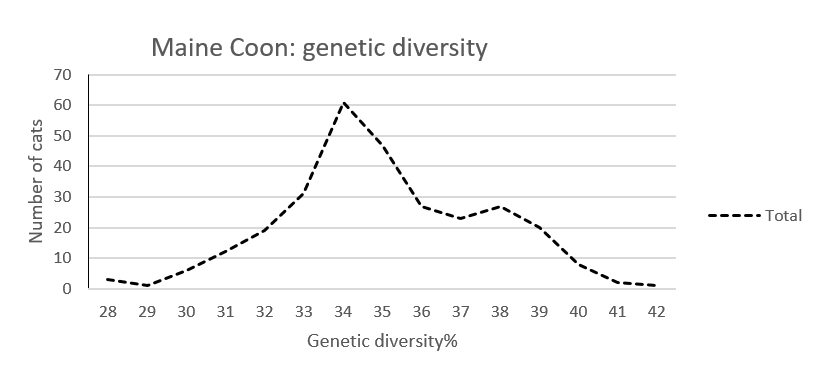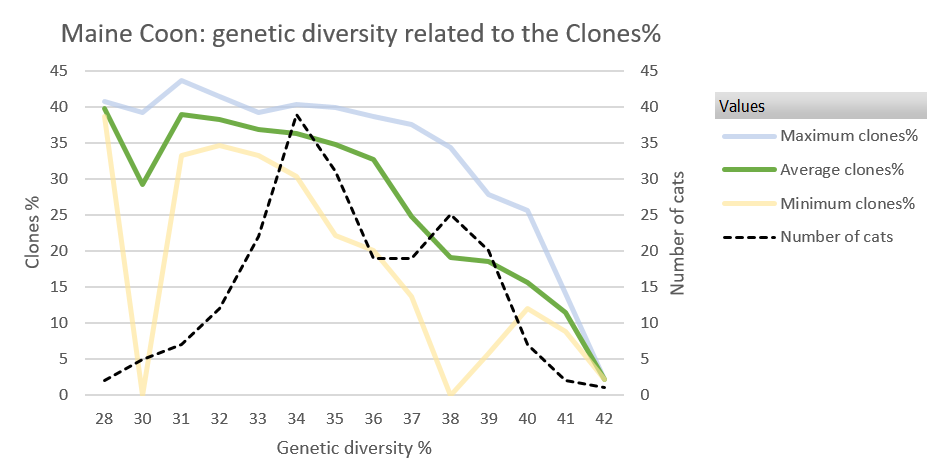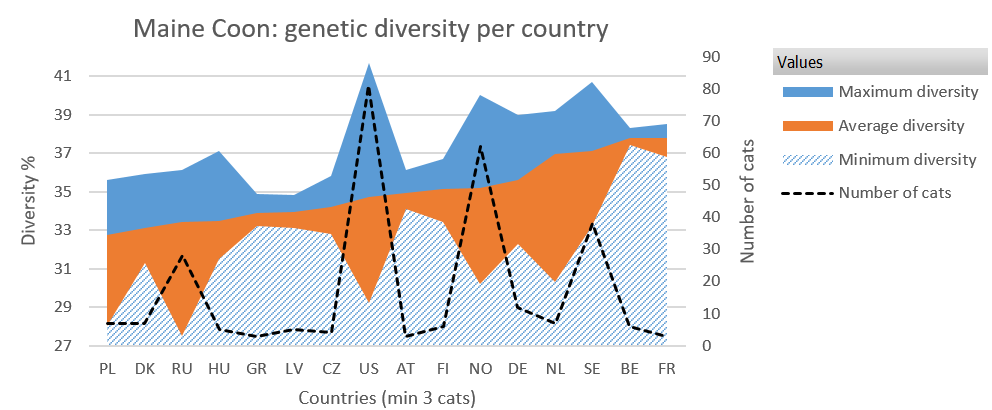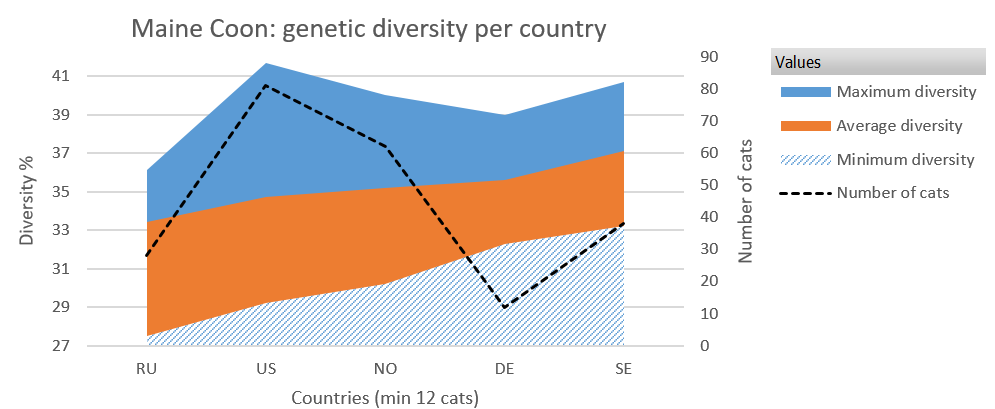Genetic diversity of the Maine Coon
Since 2018 Genoscoper launched a new DNA test. Next to the regular testing on HCM1, SMA and PK-def and traits, this test provides something very cool: insight in the genetic diversity! Thousands of genes are measured which ends up in a percentage showing the genetic diversity of the cat. This information is stored in a database and can be accessed through mycatdna.com. You can read all about this DNA test in this article "MyCatDNA".
A part of this database is set public by the owners of the cats. With the public profiles of Maine Coons, I was able to do a bit of research to create more insight on this new test genetic diversity (%) and how it relates to our conventional indicators.
This chart below shows the genetic diversity of the Maine Coon breed, which is between 28-42%. The average genetic diversity of the breed is at 34,5% at this point (22-1-2020). When more Maine Coons are being tested and added to this database in the future, the average and bandwidth of the genetic diversity can change. The chart is based on population A* (explained at the end of this article). You can see from the chart that most of the tested Maine Coons score between 32 and 39% genetic diversity. Very few Maine Coons score in the outer areas. The database contains Maine Coons from all over the world, it includes New Foundation lines, showlines, outcross and polydactyl Maine Coons. A pretty diverse Maine Coon database, which provides us a good picture of the diversity of our breed.
Does the Maine Coon have a healthy genetic diversity?
The Maine Coon is a natural breed, so one would expect it to be diverse. Although there are not many new Foundation Maine Coons added to the breed today, the breed is still considered to be diverse. The diversity does depend on the lines that are being bred with. Some lines are less diverse than others, that’s why testing is a good thing.
If you have a less diverse cat now, don't panic! By using the breedertool within MyCatDNA you can find specific cats that come from unrelated lines and can improve the genetic diversity for your future offspring. A low genetic diverse cat can still be genetically of huge importance to the population if the genes are unrelated to the majority of the breed. You can easily improve it by choosing the right partner for future matings and make a huge jump in only one or a few generation. When more cats are added and set on public, the more interesting this tool will get. It can help a breeder to improve the genetic diversity as a part of their breeding plan, besides the conventional indicators such as COI% (total inbreeding coefficient) and Clones%. It adds a new interesting perspective of information that breeders didn’t have before.
Compare different cat breeds
When you take a look at the Maine Coon breed compared to other cat breeds, you can see it is pretty high ranked on nr 6 (Polydactyl) and 8 (non-poly). As expected, the natural breeds are more genetically diverse than the breeds that were created by breeders. Note that this only shows the median (average). Every breed has it’s own bandwidth, for some breeds the bandwidth is really small and for other breeds it's very wide.
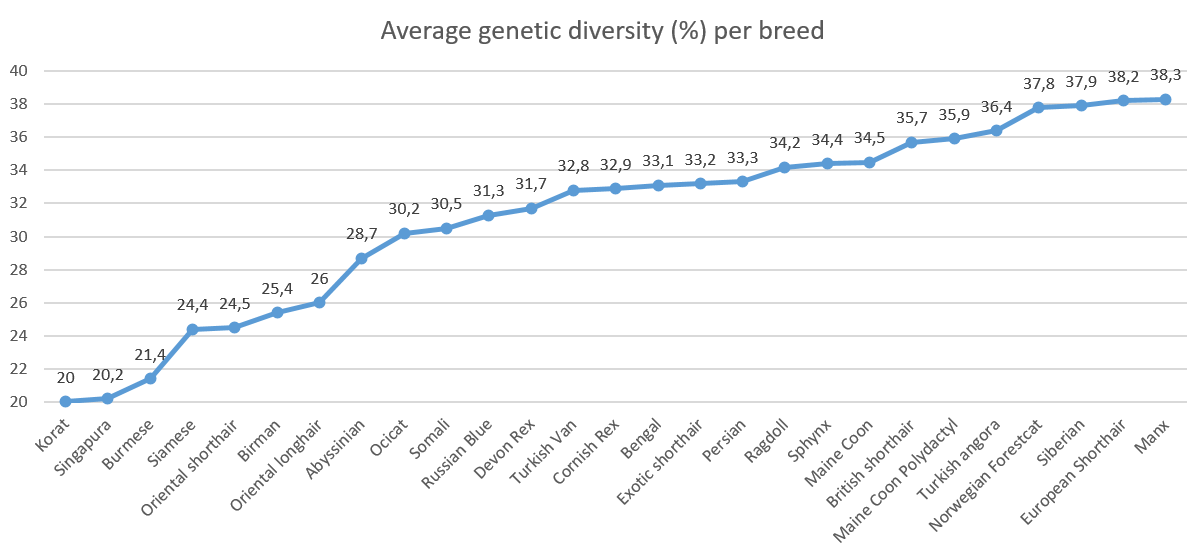
Is a domestic cat healthier than a Maine Coon?
In the Netherlands, a common thought is that a mixed breed or a domestic cat is healthier than a pedigreed cat because of their higher genetic diversity. Well the median of a domestic cat is indeed a bit higher than the median of a Maine Coon. The bandwidth of a domestic cat is between 35-42% (shown below in orange) and for a Maine Coon between 28-42% (shown below in blue). BUT depending on the breeders goals and the lines the breeder is working with, it is definitely possible to breed Maine Coons that have at least as much genetic diversity as a mixed breed or a domestic cat. Maine Coons that have a genetic diversity higher than 35% have reached that point. Obviously a breeder working with pedigreed cats has more knowledge of the lines and the quality of the genes in terms of health than a breeder who’s cat accidentally got pregnant by some neighbor’s cat we don’t know anything about. Which can make the choice for a pedigreed Maine Coon even safer than a domestic cat who's history of the ancestors is unknown and where no healthtests are done.
How can you use genetic diversity in your breeding program?
When I learned about this test, my first question was: how does the genetic diversity relates to inbreeding levels? You would expect to see a higher genetic diversity of cats who have low inbreeding levels. But is this true for every cat? I had to find out by doing research on the public Maine Coon profiles in mycatdna.com. I looked up the pedigree names in the Pawpedsdatabase in order to find information about the inbreeding levels and clones. Then I have made the charts to visualize the correlation between the indicators that we use:
-
total COI%
-
inbreeding on 5 generations and 10 generations
-
the clones
Below are the results for each indicator and the correlation with genetic diversity. All those charts are based on Population B*.
Genetic diversity correlated to COI%
Let’s have a look at how the genetic diversity relates to the total inbreeding coefficient (COI%). You can see the green line, showing the average COI versus genetic diversity (%). For example a Maine Coon that has a genetic diversity of 39% (these results are rounded) has an average COI of 5%. And a Maine Coon with a genetic diversity of 31% has an average COI of 19%.
The yellow and blue lines show the bandwidth where the COI% can be on an individual level. It shows that there is at least one Maine Coon that has a high genetic diversity of 38% and also has a higher COI than you would expect: 15%. The yellow line also shows an exceptional result of a cat that has a low genetic diversity of 30% and has a COI of 0%. How can this happen? A cat with 0% inbreeding doesn't exist, but (New) Foundation cats are registered as such, since we don't know their parents and inbreedinglevels. This shows that probably not all New Foundation cats (COI 0%) are genetically diverse. But this test can proof if they are! This particular cat probably has related parents (high COI), but could still be very unrelated to the majority of the other cats and bring in new genes to the population.
The black dotted line shows how many Maine Coons fall into the genetic diversity category. The outer edges don’t have as much testresults to draw reliable conclusions here. But the trend (green line) is very visible. In other words, there is a correlation between the COI and the genetic diversity, but it is not as predictable, since there are exceptions.
You can make general predictions here: A Maine Coon with COI of 15% is likely to have a genetic diversity less than 35%, but you can see from the blue line that 38% is still possible also. Maine Coons that have lower inbreeding levels then 10% will probably have a genetic diversity level between 36,5 and 40,5%. In a low COI% pedigree nowadays often one or more New Foundation cats are responsible for the low numbers. But the genetic diversity does depend on the genetic diversity level of the New Foundation cat and how unrelated those genes are to the lines you mix them with. This test adds new information about the genetic diversity of that new line and if it indeed adds something new to the breed.
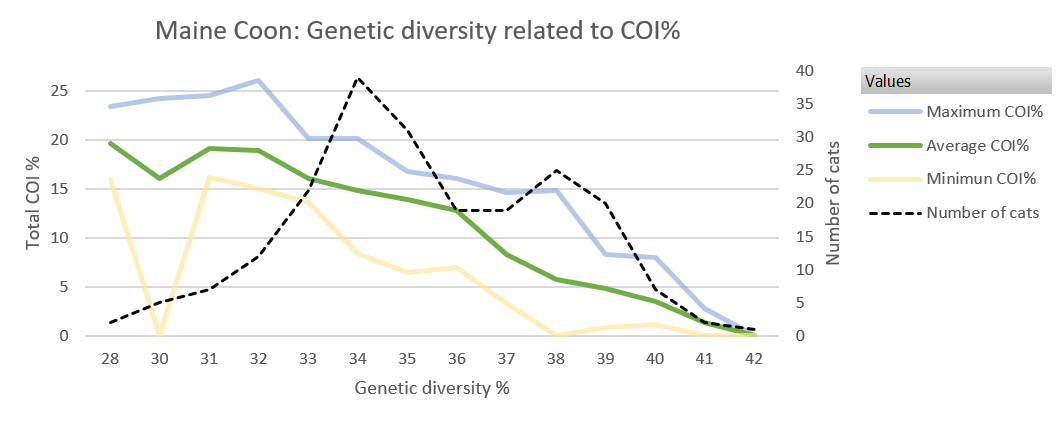
Genetic diversity correlated to inbreeding and linebreeding
So we have had a closer look at the total COI levels, but what about the inbreeding levels that are more recent in the pedigree? I’ve added two categories here. The inbreeding level within 5 generations, that shows how related the cats are looking only at the last 5 generations. The second one is the linebreeding that was done in the last 10 generations, how many double ancestors do you find there? Although there are not many examples of extreme inbreeding in the database to derive good conclusions from them, you can still see in the chart below, that in order to be on the higher side of genetic diversity, it is wise to keep the inbreeding levels of the last 10 generations of your future matings below 2% (results > 34%) or preferable below 1% (results > 37%). That being said, a Maine Coon with 10 generation inbreeding level of 6% can still have a genetic diversity of 38%. Chances are small, but it happens. I guess this was the lucky cat that inherited the unrelated parts of the related parents.
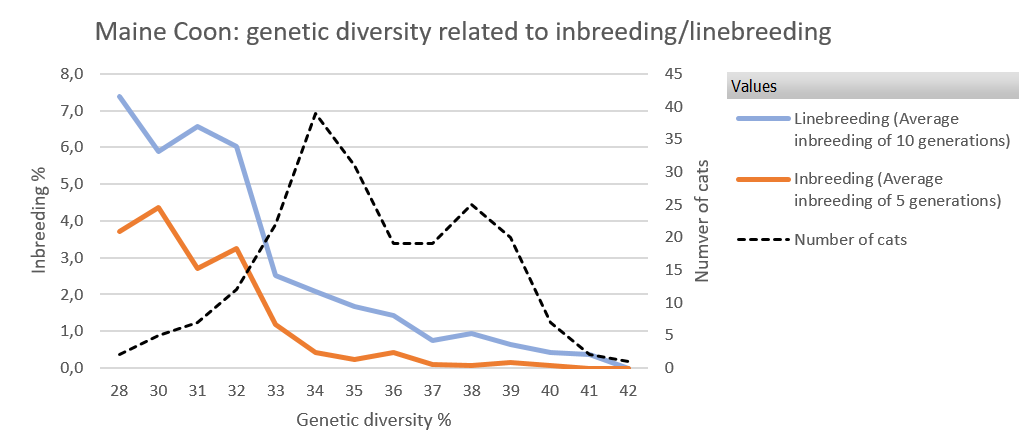
In case you didn’t already realize that inbreeding is not a good idea health-wise, the breeder tool helps you visualizing the results when you plan to mate related cats.
Example 1:
Brother – sister mating increases the COI with 25%. What happens with the genetic diversity when you plan such a mating (which is not recommended)? In the breeder tool you can match the profile of Chelles of Macadamia (genetic diversity of 39,2%) with her brother Lyon of Macadamia (genetic diversity of 37,8%). (Note that brother and sister have a difference of 1,4%, which shows that not all siblings have the same genetic diversity.) Their kittens are expected to have a genetic diversity around 29,7%. A decrease of 8,8% in genetic diversity. You don’t get them much lower than that! Obviously a very bad idea.
Example 2:
Grandparent – grandchild mating increases the COI with 12,5%. We take the profile of Chelles of Macadamia (39,2%) again and this time we will select her grandfather So Out Coon’s Mirai (38,5%). Both cats have a very good genetic diversity. The expected genetic diversity of their kittens will be around 34,9%. A decrease of nearly 3,95% in genetic diversity in just one generation. It seems a small number and small step, but don't take a few percent very lightly. It takes you straight to the other side of the chart. Remember the bandwidth of the tested Maine Coon population is only 14% (between 28-42%), so a decrease of 3,95% means you will lose 28% of their genetic diversity in one step!
Genetic relations
Note that mycatdna database doesn't keep track of any family relationships. The prediction of the genetic diversity for the offspring is purely based by comparing the genomes. If the predicted genetic diversity is lower than both parents, it means their genomes is mostly the same (and they are probably related).
At the genetic relations map of the testresults you can see all the cats of the breed and how they cluster together when their genomes have similarities. Think of this: when you have a Maine Coon with a high genetic diversity, lets say 40%, but it is shown in the graphic in the middle of the blue cluster of dots. It means you will have a hard time finding a good match to further improve genetic diversity, since most of the other cats are close to yours and share most of the same DNA. You will have to look for lines in the outer areas to find unrelated matches, to continue a high genetic diversity for future generations.
Surprisingly the graphic below shows that the domestic long hairs and the Maine Coon mixed cats are all in the same yellow cluster. Showing that their DNA is different from the Maine Coon breed, but within this mixed-breed-category there is not very much diversity at all.
Also notice that the Polydactyl Maine Coons (pink dots) seems to be very diverse. The Polydactyls are registered as a separate breed into Mycatdna and has its own median of 35,9%, which is 1,4% higher than a non-poly Maine Coon (34,5%).
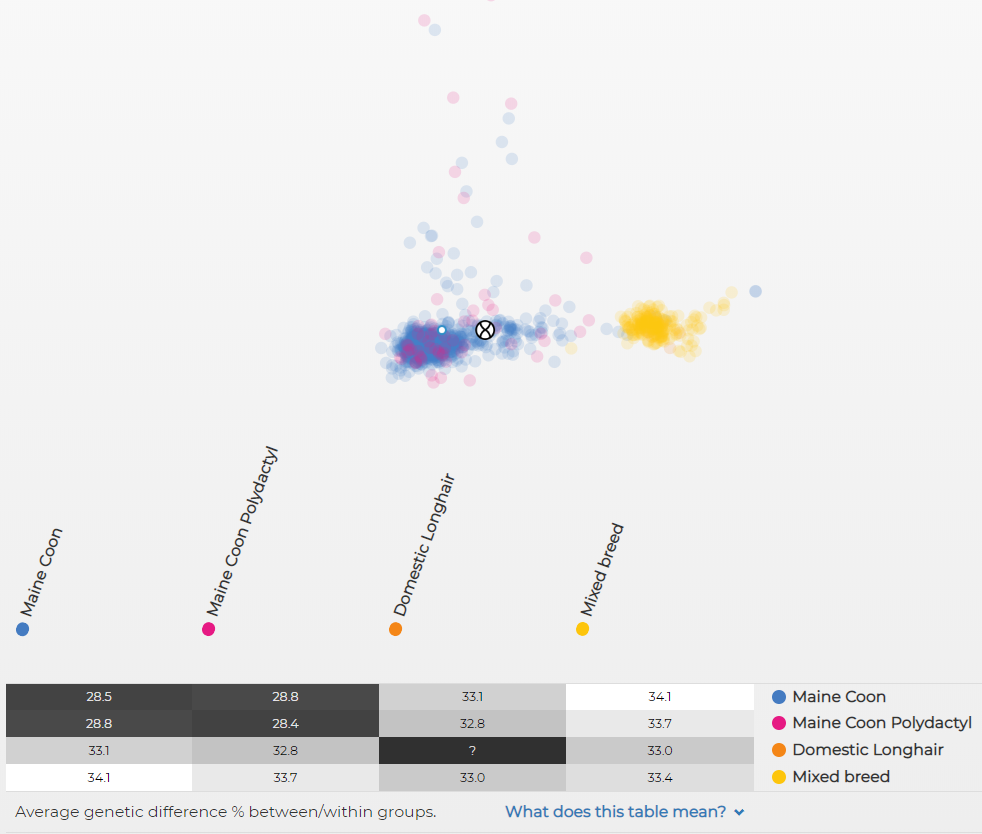
Genetic diversity correlated to the Clones
How is the genetic diversity related to the clones? We know that a high clone percentage means you have a lot of the same ancestors (clones and behind them the top 5). When you don't know about the clones, please read more about it in my article "The influence of the clones" first.
Look at the chart below. When you are breeding outcross cats by keeping the clones below 20%, the cats will most likely all have a genetic diversity higher than 36%. On average they are even higher than 38%. Which is very good news and proof for every outcross breeder, that you are indeed working on a higher genetic diversity with outcross lines. Of course you already knew that, but it is good to have some proof!
Knowing that the average clone percentage is around 35%, this chart shows that the majority of these cats are on the left side of the chart, having a genetic diversity below 35%.
So I think we can say that there is a correlation between the genetic diversity and the clones. What fascinates me is the question why these lines are more curved? The previous chart of the COI showed a more straight line. I haven't found an answer yet.
Genetic diversity per country
This is a fun chart, but it is also the least reliable chart of all. Since some of the countries only have very few cats tested we can’t really jump into conclusions yet. This chart shows only the countries which have a 3 cats minimum inside the public database. This chart is based on Population C*. The country where the cat was born (and where the breeder is located) is the country where the cat is counted for.
The black line shows how many cats it contains and therefor you get a more reliable picture for the countries that have more cats tested.
As expected, the Maine Coons with the highest genetic diversity are found in the US, as New Foundation cats that bring new genes all come from the US (or CA). But you can see that they also have quite a lot of cats with a lower genetic diversity, which is most likely caused by American breeders importing less diverse cats from overseas.
You can also see that Sweden is doing very well keeping the genetic diversity high. Of all the countries on the left side, Russia sticks out with a lower genetic diversity of on average 33%. During my research I have noticed that most of the Russian cats who are in the mycatdna database are now owned by American breeders, which will probably bring the genetic diversity down within their breeding programs. This can be seen in future tested generations from US breeders.
If you take out the countries that has less than 12 cats tested, you are left with the top 5 countries that have the most cats tested within mycatdna. This chart is based on Population D*.
Conclusion
The genetic diversity shows to be a promising new indicator. Since chance also plays a part how the genes are inherited by the offspring, it is less predictable than the usual indicators as COI, Clones and Top5. It could be more challenging to integrate this into your breedingprogram. With low inbreeding levels you are aiming for higher diversity, but with this test you will actually KNOW the cat's genetic diversity. This test is factual and therefor more reliable than the other indicators, so it certainly has a lot of value. The mycatdna website gives us breeders the opportunity to keep track of the genetic health of the whole breed.
Of course we mustn’t stare blind on the diversity alone though, diversity doesn’t necessary means the cat has healthy genes. You could still end up with a high genetically diverse cat who inherited the wrong genes that messes things up. Also the genetic information should never replace any HCM/PKD test by echo, HD/PL test or other clinical health checks carried out by a veterinarian or specialist. This DNA test is only a small part of the total health tests that a breeder is recommended to do for a Maine Coon.
But I must say I am a fan of this test and very enthusiastic about the positive impact that the breeding tool can have in the future, especially when more cats are added. It could be fun (or scary, depending the direction it is heading) to follow the trends for the upcoming years.
Population and source
On the website of mycatdna, I’ve took the whole population of Maine Coons (polydactyl included) from the public cats. There are many more Maine Coons tested but their profile can’t be seen by me, so I could only work with the public cats. On January 22th, 2020 the population of public Maine Coons were 288 testresults. From those cats, I have checked their pedigree in the Pawpeds database to search for information on COI, inbreeding of 5, 10 generations and the Clones. I could find 212 of the cats in the Pawpedsdatabase. From those 212 cats I also noted their country of birth. For the 76 cats that were not found in Pawpeds, their mycatdna profile gave me information on the country of birth.
*Used populations shown in the charts in this article:
-
Population A: 288 Maine Coons Total public Maine Coon profiles on mycatdna.com at 22-01-2020 (polydactyl included)
-
Population B: 212 Maine Coons Population A minus the 76 cats that could not be found in the Pawpeds database
-
Population C: 277 Maine Coons Population A minus the cats that were born in countries where only one or two cats are published
-
Population D: 221 Maine Coons Population A minus the cats that were born in countries where less than 12 cats are published
By: Debbie Sprenger

